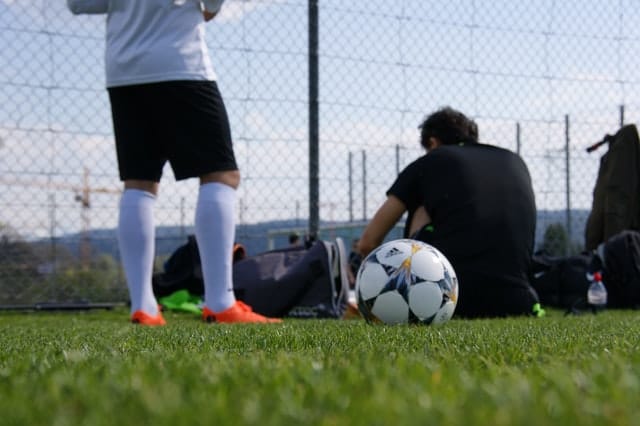Getting the inflation pressure of a soccer ball right is a must before any soccer match. A non-properly inflated soccer ball can very easily affect the performance of the soccer players on the field. With that said, the question becomes how hard should the soccer ball be.
A soccer ball used in a professional soccer match is usually rock hard. Harder soccer balls mean that the balls will be able to travel longer distances when kicked using the same amount of force.
How hard should a soccer ball be during a professional soccer match?
According to the FIFA regulations, the soccer ball should have a pressure between 8.81757 psi (0.6 atm) and 16.1655 psi (1.1 atm).
You can easily notice that FIFA allows for a wide range of pressure values for a ball. One of the reasons behind that could be that different soccer balls require different amounts of air pressure inside them for them to function as expected.
With that said, how hard should your soccer ball be?
The answer is that it depends.
If you are considering soccer as a career option, then you should use a rock hard soccer ball whenever you’re playing or practicing soccer. Try to use the air pressure amount that FIFA requires for professional soccer matches.

This way, you’ll build up your muscle memory using a soccer ball with a pressure value equivalent to the one used during professional matches.
It’s extremely important to get used to playing with a rock solid soccer ball if you are planning to become a professional soccer player one day.
However, if you’re playing soccer with your friends just for fun, then you might need to use a soccer ball with a little bit less pressure than the one used during professional soccer matches.
The reason you might want to do that is because a hard soccer ball can cause more injuries during a soccer game, especially when a player is performing a header.
While headers are an essential part of a soccer match, they can sometimes be dangerous if they’re not performed correctly, and a rock hard soccer ball can make things worse.
Most soccer balls will have labels on them recommending the pressure range that should be used. If you’re playing soccer for fun, then just pick a pressure amount from the lower range.
How to check the pressure of the ball?
You now know what pressure to aim for, but how can you tell the ball’s pressure? There are a few methods that you can use.
1- Use an air pressure gauge.
The most reliable way to measure the amount of air pressure inside a soccer ball is to use an air pressure gauge.
Using an air pressure gauge is super simple. Just insert the needle into the ball’s valve and you’ll be able to read the pressure level. Make sure that you insert the needle perpendicularly in order not to ruin the ball.
2- use your muscle memory
It’s true that using an air pressure gauge will allow you to get an accurate value of the air pressure inside the ball, just using your muscle memory to test the air pressure inside the ball might be a better idea.
The reason behind that is that you want the ball to feel right, and what better way to test that than to play with it?
Keep pressing the ball with your finger while you’re inflating it. Stop inflating it when you think you got the right amount of air inside it.
Then just use the ball for a few seconds. Try to juggle the ball, run with it, and kick it. If the air pressure inside the ball isn’t good, you’ll immediately feel it if you’ve been playing soccer for a while.

Using your muscle memory, you’ll be able to tell if the ball needs more/less air pressure. Keep adjusting the air pressure inside the ball and testing it until it feels right.
Usually, professional soccer players can very easily tell if the ball isn’t inflated properly by just kicking it a few times. If they detect a non-properly inflated ball, they ask the referee to check the ball and replace it.
You too will be able to very easily tell if a soccer ball isn’t properly inflated after you play a few soccer matches.
With that said, I’ll end the article with a quick summary.
If you’re planning to be a professional soccer player, then your soccer ball should be rock solid when you’re training or playing soccer.
However, if you’re just playing soccer for fun, then try to put less pressure inside the ball in order not to increase your risks of injury. In this case, just keep adding air pressure inside the ball until it feels right.

